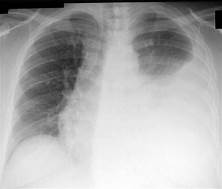Immediately after log-rolling a client to a lateral position, which intervention should the practical nurse (PN) implement?
Raise the head of the bed 30 degrees
Measure blood pressure and pulse rate
Flex legs and place blanket between legs
Place pillows to maintain alignment.
The Correct Answer is D

Nursing Test Bank
Naxlex Comprehensive Predictor Exams
Related Questions
Correct Answer is A
Explanation

The correct answer is choice A. Gather the procedure tray and equipment.
Choice A rationale:
The practical nurse should gather the necessary procedure tray and equipment to ensure everything is ready for the healthcare provider to perform the thoracentesis efficiently and safely.
Choice B rationale:
Cleansing the site and covering it with a sterile towel is part of the procedure itself and should be done by the healthcare provider performing the thoracentesis.
Choice C rationale:
Keeping the patient NPO (nothing by mouth) and encouraging them to void is not necessary for a thoracentesis. This procedure typically does not require the patient to be NPO.
Choice D rationale:
Placing the patient in an orthopneic position (sitting up and leaning forward) is important for the procedure, but it should be done closer to the time of the procedure, not necessarily as a preparatory step.
Correct Answer is D
Explanation
Choice A rationale:
Sinus tachycardia may occur in response to various stressors or physiological conditions but is not directly related to anorexia nervosa or severe malnutrition. It is not the primary pathological process resulting from this condition.
Choice B rationale:
Menstrual cramps are not a pathological process but rather a symptom that may result from hormonal changes or other factors. While amenorrhea (absence of menstrual periods) is a common feature of anorexia nervosa, menstrual cramps are not a primary concern in this context.
Choice C rationale:
Hypertension is not typically associated with anorexia nervosa or severe malnutrition. In fact, individuals with anorexia nervosa often experience hypotension (low blood pressure) due to dehydration and nutritional deficiencies.
Choice D rationale:
Amenorrhea is the primary pathological process resulting from the adolescent's consistent maladaptive behavior of anorexia nervosa. Severe malnutrition and low body weight can disrupt the normal menstrual cycle and lead to amenorrhea. This is a significant concern for individuals with anorexia nervosa and can have long-term health implications.
Whether you are a student looking to ace your exams or a practicing nurse seeking to enhance your expertise , our nursing education contents will empower you with the confidence and competence to make a difference in the lives of patients and become a respected leader in the healthcare field.
Visit Naxlex, invest in your future and unlock endless possibilities with our unparalleled nursing education contents today
Report Wrong Answer on the Current Question
Do you disagree with the answer? If yes, what is your expected answer? Explain.
Kindly be descriptive with the issue you are facing.
